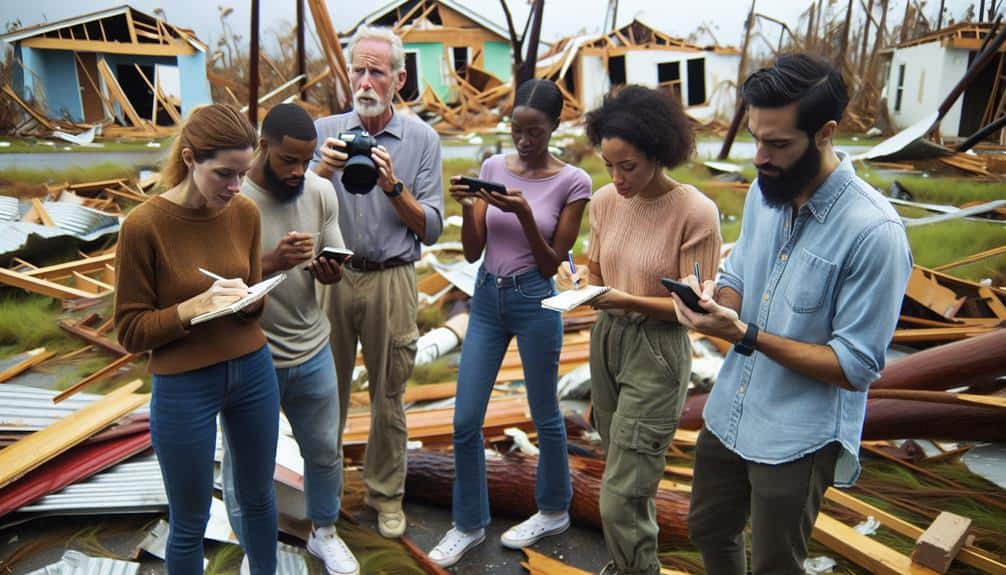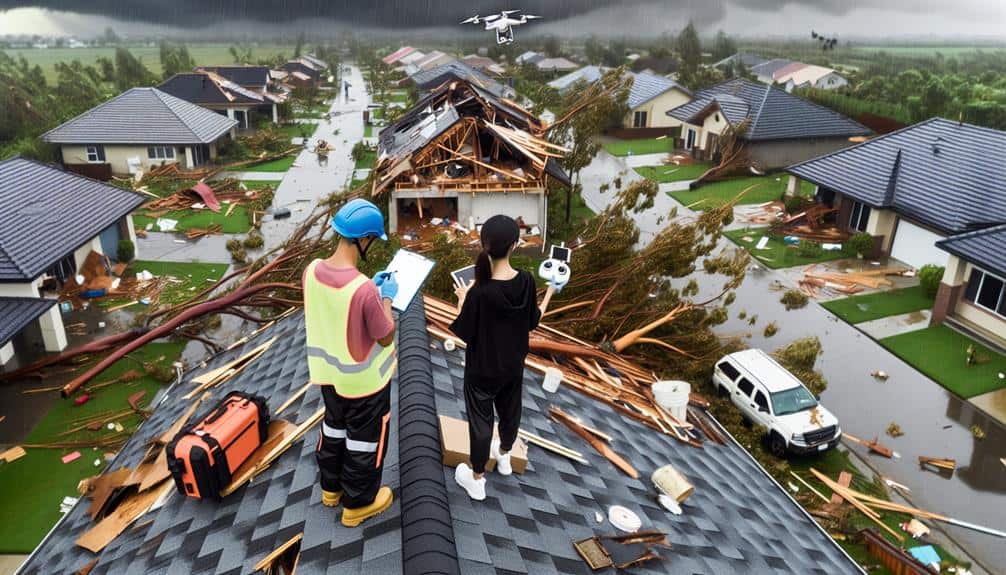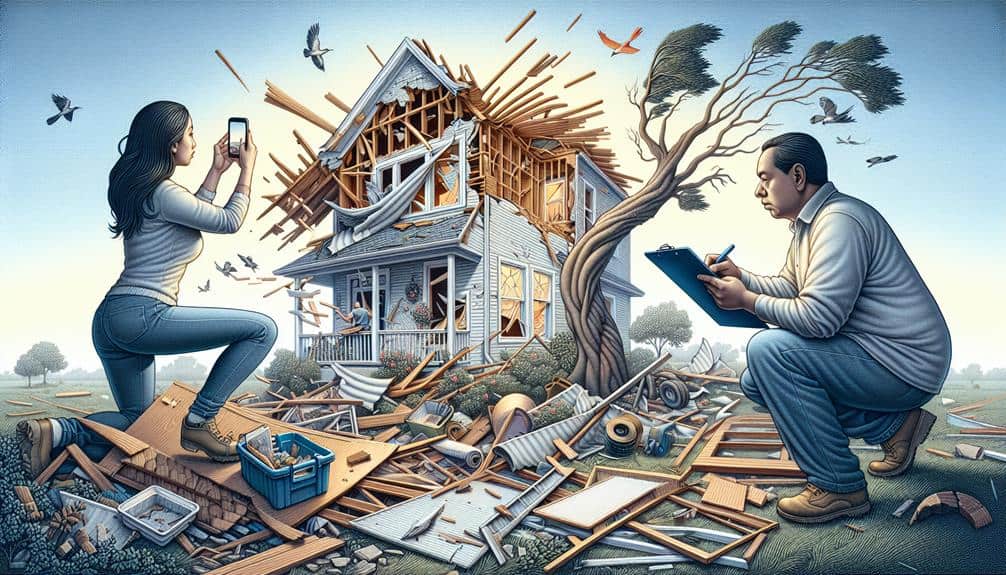When documenting storm damage, we start by verifying the area's safety, consulting local authorities if needed, and wearing protective gear to stay vigilant for hazards. We capture detailed photos and record extensive videos, making sure everything is date-stamped. We take thorough notes, describing the damage meticulously and collect witness statements for personal accounts. Organizing and storing evidence methodically is essential, so we categorize damage types, label evidence clearly, and use digital backup methods for secure storage. By maintaining an updated digital inventory with clear descriptions, we ensure easy retrieval. Follow these steps carefully to be well-prepared for any necessary follow-ups.
Key Points
- Wear protective gear and survey the area for risks before documenting.
- Capture comprehensive photos and detailed videos of all damages with date stamps.
- Take thorough notes and collect witness statements for a detailed account.
- Categorize and label all evidence, ensuring secure digital backups.
Assess Safety First
Before documenting any storm damage, we must verify that the area is secure and free from immediate dangers. Our first step is to evaluate risks such as downed power lines, unstable structures, and floodwaters. These can be significant threats, so prioritizing safety is crucial.
We should scan the environment thoroughly, looking for any signs of peril that could compromise our well-being.
Next, we need to determine if it's safe to proceed. If there's any doubt, we shouldn't hesitate to consult with local authorities or emergency services. They can provide vital information about ongoing risks and necessary precautions.
Once we've confirmed that the area is secure, we can move forward systematically. Wearing appropriate protective gear like gloves, sturdy boots, and helmets will further guarantee our safety. We should remain vigilant for less obvious hazards, such as sharp debris or hidden structural weaknesses.
By being methodical and cautious, we can prevent accidents and injuries.
Let's remember that our primary goal is to assess and document the damage accurately, but not at the expense of our safety. Evaluating hazards and prioritizing safety sets the foundation for everything we'll do next.
Capture Comprehensive Photos
Now that we've confirmed the area is safe, let's systematically capture thorough photos of the storm damage. This is important for property assessment and ensuring responsibility when filing insurance claims. We need to be methodical and detailed in our approach to gather solid evidence.
Start by photographing the overall exterior of the property. This gives a clear view of the extent of the damage. Next, zoom in on specific areas that show signs of storm impact. Make sure these photos are clear and well-lit to avoid any uncertainty.
Exterior shots: Capture images of the roof, walls, and surrounding landscape. Look for structural damage such as missing shingles or fallen trees.
Interior damage: Document any water damage, broken windows, or compromised walls and ceilings. Pay attention to areas where the storm might've caused leaks.
Personal property: Take photos of damaged furniture, electronics, and other valuable items. Be sure to capture serial numbers if possible.
Record Detailed Videos
Let's make sure we record detailed videos that clearly capture all visible damage.
We'll include date stamps in our videos to provide accurate timelines.
Capture Damage Clearly
To effectively document storm damage, we should record detailed videos that capture every angle and aspect of the affected areas. Ensuring thorough visual evidence is essential for accurate damage documentation. When we walk through the damaged site, we need to methodically film each section, focusing on both wide views and close-ups of specific damages.
Key points to keep in mind while recording:
- Capture all angles: Move around the damage site, capturing footage from various perspectives to show the extent of the damage clearly.
- Zoom in on details: Highlight specific areas of damage, such as cracks, fractures, and water stains, to provide detailed visual evidence.
Include Date Stamps
Incorporating date stamps into our videos guarantees we've a clear and precise record of when the damage occurred. This step is essential in the documenting process, as it establishes a timeline that can be crucial during insurance claims or legal proceedings. By doing this, we confirm the accuracy and thoroughness of our documentation, which can greatly influence the outcome of any potential disputes.
When we record detailed videos, we must focus on capturing every angle and aspect of the storm damage. Including a date stamp on each video provides an indisputable reference point, which can be necessary if the timing of the damage is ever questioned. This practice enhances the credibility of our documentation, making it more reliable and trustworthy.
The importance of accuracy can't be overstated. A precise and meticulous documenting process helps eliminate ambiguities and supports our claims with solid evidence. We should always aim for thoroughness, ensuring that we don't miss any crucial details.
The legal implications of inadequate or inaccurate documentation can be severe, potentially leading to denied claims or prolonged disputes. As a result, integrating date stamps into our video recordings isn't just a recommendation; it's a necessity for protecting our interests and ensuring a smooth claims process.
Take Thorough Notes
We need to meticulously document every detail of the storm damage to guarantee accurate records and streamline any insurance claims. Taking thorough notes is essential in capturing the full extent of the damage. Here are some practical note-taking tips to make sure we don't miss anything vital.
- Describe the Damage: Write detailed descriptions of what we see, including the type and extent of damage. For example, note if there are broken windows, roof damage, or flooded basements.
- Specify Locations: Clearly indicate where each damage occurs. Noting specific rooms, corners, or exterior areas helps create a thorough picture.
The documentation importance can't be overstated. Our detailed records aid not just in insurance claims but also in planning repairs and communicating with contractors. By being methodical in our note-taking, we empower ourselves to manage the aftermath of a storm with clarity and confidence.
Collect Witness Statements

After meticulously documenting the physical damage, it's equally important to gather witness statements to capture personal accounts of the storm's impact. First, we should identify potential witnesses who experienced the storm firsthand. Neighbors, local business owners, and even passersby can provide valuable insights. We should approach them respectfully, explaining our purpose clearly and making sure they feel comfortable sharing their experiences.
When we interview witnesses, it's critical to ask open-ended questions. For example, we might ask, 'Can you describe what you saw during the storm?' or 'How did the storm affect your property?' These questions encourage detailed responses that can provide a thorough view of the storm's impact. It's also important to note the time and date of each interview, as well as the witness's contact information, for follow-up if necessary.
As we gather accounts, we should document them accurately. Using audio recordings can guarantee we capture every detail without the risk of misinterpretation. However, always seek permission before recording. Written statements should be clear and thorough, reflecting the witness's exact words.
Organize and Store Evidence
Let's systematically categorize the damage by type, ensuring each piece of evidence is clearly labeled and easy to reference.
We'll also utilize digital backup methods to safeguard our documentation, making it accessible and secure.
Categorize Damage by Type
To effectively document storm damage, categorizing the damage by type and systematically organizing and storing evidence for future reference are essential. By doing so, we streamline the damage assessment process and enhance the accuracy of insurance claims.
Let's break down the steps methodically.
First, we should categorize the damage into specific types such as structural, water, wind, and debris damage. This classification helps us focus on each category individually, ensuring no detail is overlooked. For instance, structural damage might include issues with the foundation, walls, and roof, while water damage could encompass flooding and leaks. Wind damage might involve broken windows or exterior features, and debris damage could include fallen trees or scattered debris.
Next, we need to organize the collected evidence. We can do this by creating separate folders for each damage type. Documenting each type separately simplifies the process of filing insurance claims and provides a clear and organized record for future reference.
Here's a concise approach:
- Create folders for each damage type.
- Label and date all photos and videos.
Utilize Digital Backup Methods
Once we've organized our physical evidence into folders, it's important to employ digital backup methods to guarantee the security and accessibility of our documentation. The first step is to create a digital inventory of all the evidence we've collected. This inventory should include detailed descriptions, dates, and any other relevant information. By keeping this inventory updated, we make sure that we've a detailed overview of our documentation.
Next, we need to scan or photograph all physical documents and images. High-quality scans or photos will ensure that all details are preserved. Once digitized, we should store these files in a systematic manner, using clear and consistent naming conventions for easy retrieval.
Cloud storage is an excellent solution for backing up our digital files. Services like Google Drive, OneDrive, or Dropbox offer secure and accessible storage options. By uploading our digital inventory and scanned documents to the cloud, we protect our evidence from physical damage or loss. Additionally, cloud storage allows us to access our files from anywhere, providing flexibility and freedom.
Frequently Asked Questions
How Soon Should I Contact My Insurance Company After Documenting Storm Damage?
We should contact our insurance company immediately after documenting storm damage. Quick timing is important for our insurance claim. Let's guarantee property protection by taking all necessary precautions, and promptly report to expedite the process.
Can I Start Repairs Before My Insurance Adjuster Visits?
Did you know 25% of claims are denied due to premature repairs? Let's not risk our insurance coverage. We should verify the repair timeline with our insurer and wait for the adjuster before starting any fixes.
What if I Discover Damage After the Initial Documentation?
If we discover damage post initial documentation, we should update our insurance company right away. Timely post damage assessment and mitigation can guarantee our insurance coverage remains intact and we meet any critical deadlines.
Should I Hire a Professional to Assess the Damage?
Imagine a ship sailing through stormy seas. Should we trust our DIY assessment or seek a seasoned captain? Hiring a professional offers precision, but we must weigh cost comparison against potential hidden damages. Safety often justifies the expense.
How Do I Protect My Property From Further Damage Before Repairs?
To safeguard our property from further damage before repairs, let's implement prevention measures. We can use temporary fixes and DIY solutions like tarping roofs, boarding windows, and sealing leaks. These steps guarantee property protection until professional repairs can begin.


